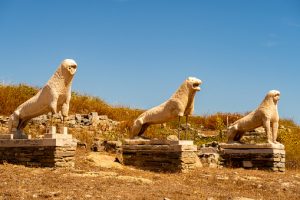The Sacred island of Delos in the Cyclades Greece
MYTHOLOGY | HISTORY | WHAT TO SEE | GETTING THERE
The island of Delos, in the heart of the Cyclades in Greece, is a tiny, rocky island of approximately 5km long and 1300m wide. For the ancient Greeks it was the most sacred place of Ancient Greece. Indeed, one theory states that the very name given to the Cyclades group of islands in the Aegean sea comes from the word, circle or ‘kyklos’ that they formed around the island of Delos. The ancient city that stretched here was a center of commerce as well as a place of worship. However, it takes imagination to understand that this immense collection of ruins was once a prosperous city. While many objects discovered in Delos, most off them are on display at the National Archaeological Museum of Athens, the island museum still has an interesting collection of statues , mosaics and vases.
Delos is a significant archaeological and historical site located in the Aegean Sea. It is part of the Cyclades archipelago and lies close to the island of Mykonos. Historically, Delos has been considered sacred as the mythological birthplace of Apollo and Artemis, two of the most important deities in the Greek pantheon. This religious significance made Delos a major cultural and religious center during ancient times.
The history of Delos is rich and complex, stretching back to the 3rd millennium BC. The island became a prominent religious sanctuary and was inhabited by various peoples over the centuries, including the Ionians who developed it significantly in the 7th century BC. The island’s central location in the Aegean made it a bustling hub for trade, which contributed to its wealth and development. It was especially known for its monumental sanctuaries, beautiful temples, and other structures dedicated to various gods and goddesses.
In the Hellenistic period, particularly in the 2nd century BC, Delos was declared a free port by the Roman Republic, which led to an increase in commerce and the arrival of traders, merchants, and various settlers from around the Mediterranean. This period saw Delos at its peak, with a diverse population and a rich urban landscape featuring houses, markets, and public buildings.
However, the prosperity of Delos did not last. The island suffered from attacks and lootings, and by the end of the 1st century BC, it began to decline. The introduction of competing trade routes and the shift of power in the Mediterranean world led to its gradual abandonment. By the end of the Roman Empire, Delos was largely deserted, leaving behind a vast archaeological treasure.
Today, Delos is recognized as a UNESCO World Heritage site, acknowledging its outstanding value to humanity. The ruins on the island offer insights into ancient Greek civilization and include well-preserved temples, sanctuaries, theaters, and homes. Archaeological excavations have unearthed exquisite mosaics, statues, and other artifacts that shed light on the daily life, religion, and culture of its ancient inhabitants.
The preservation and study of Delos continue to contribute significantly to our understanding of ancient Greek and Roman history, religion, and culture. Visitors to the site can explore the ancient ruins and experience the historical and spiritual significance of this unique island, which once stood as a beacon of religious devotion and commercial prowess in the ancient world.






What to see

The ruins of the town that can be seen today developed in around 167 BC. This development came about as a result of Delos being declared a free port leading to a congregation of all eastern Mediterranean commercial activity on the island. Many rich bankers, merchants and ship-owners from the ancient world chose to settle on Delos, which in turn attracted tradesmen and craftsmen employed to construct the wonderful houses, statues, frescoes and mosaic floors to adorn these luxury mansions. Estimations suggest that by the early 1st century BC the population of the tiny island of Delos was around 30,000 and approximately 750,000 tons of merchandise was moved through its ports every year. It is no wonder then that it earned the reputation as the world’s greatest commercial centre.
Getting there
A day trip to Delos is a must when you are in Mykonos. It takes less then 40 minutes with the local boats that departing daily from Mykonos. The best time to go is at 10 am so you can return with the boat of 1.15. The time is plenty to go around the Ancient city and see all the amazing ruins of this sacred island. Just before the museum there is a small snack bar where you can eat something and have some refreshments.
On the boat you will get a free map and a guide for the ancient city, very useful if you are not going there with a guided group. But there is no problem to follow a guided group and hear the tour guide. As you enter the area you will go through the several temples that where build by many Greek city states.
